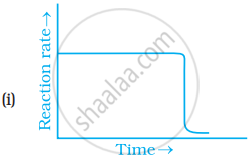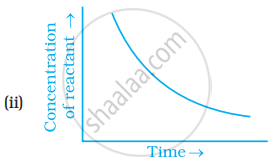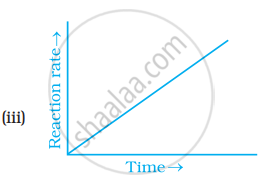Advertisements
Advertisements
Question
The reaction between A and B is first order with respect to A and zero order with respect to B. Fill in the blanks in the following table:
| Experiment | A/mol L−1 | B/mol L−1 | Initial rate/mol L−1 min−1 |
| I | 0.1 | 0.1 | 2.0 × 10−2 |
| II | ______ | 0.2 | 4.0 × 10−2 |
| III | 0.4 | 0.4 | ______ |
| IV | ______ | 0.2 | 2.0 × 10−2 |
Solution
| Experiment | A/mol L−1 | B/mol L−1 | Initial rate/mol L−1 min−1 |
| I | 0.1 | 0.1 | 2.0 × 10−2 |
| II | 0.2 | 0.2 | 4.0 × 10−2 |
| III | 0.4 | 0.4 | 8.0 × 10−2 |
| IV | 0.1 | 0.2 | 2.0 × 10−2 |
The rate of the reaction is given by,
Rate = k [A]1 [B]0
⇒ Rate = k [A]
From experiment I, we obtain
2.0 × 10−2 mol L−1 min−1 = k (0.1 mol L−1)
⇒ k = 0.2 min−1
From experiment II, we obtain
4.0 × 10−2 mol L−1 min−1 = 0.2 min−1 [A]
⇒ [A] = 0.2 mol L−1
From experiment III, we obtain
Rate = 0.2 min−1 × 0.4 mol L−1
= 0.08 mol L−1 min−1
= 8.0 × 10−2 mol L−1 min−1
From experiment IV, we obtain
2.0 × 10−2 mol L−1 min−1 = 0.2 min−1 [A]
⇒ [A] = 0.1 mol L−1
APPEARS IN
RELATED QUESTIONS
The decomposition of NH3 on a platinum surface is a zero-order reaction. If the rate constant (k) is 4 x 10-3 ms-1, how long will it take to reduce the initial concentration of NH3 from 0.1 M to 0.064 M?
Give one example of zero order reaction.
Derive integrated rate law for a zero-order reaction \[\ce{A -> Product}\].
For which of the following reaction the units of rate constant and rate of the reaction are same?
At high pressure the following reaction is zero order.
\[\ce{2NH3(g) ->[1130 K][Platinum catalyst] N2(g) + 3H2(g)}\]
Which of the following options are correct for this reaction?
(i) Rate of reaction = Rate constant.
(ii) Rate of the reaction depends on concentration of ammonia.
(iii) Rate of decomposition of ammonia will remain constant until ammonia disappears completely.
(iv) Further increase in pressure will change the rate of reaction.
Which of the following graphs is correct for a zero order reaction?




Derive an expression to calculate time required for completion of zero order reaction.
For a zero order reaction will the molecularity be equal to zero? Explain.
A solution with initial concentration of a mol dm-3 follow zero order kinetic. The time taken for the completion of reaction is
Consider the following statement:-
(i) Increase in concentration of reactant increases the rate of a zero-order reaction.
(ii) Rate constant k is equal to collision frequency A if Ea = 0
(iii) Rate constant k is equal to collision frequency A if Ea = 0
(iv) In k vs t is a straight line
(v) In k vs 1/T is a straight line
Which of the above statement is correct?
For a zero-order reaction, the plot of [A]t vs t is linear with a ______
Write the expression of integrated rate equation for zero order reaction.
If the initial concentration of substance A is 1.5 M and after 120 seconds the concentration of substance A is 0.75 M, the rate constant for the reaction if it follows zero-order kinetics is ______.
Derive the expression for integrated rate law for zero order reaction A → Products.
Write the unit of rate constant of zero order reaction.
What is zero order reaction?
If unit of rate constant is mol dm−3s−1, the order of reaction would be ______.
